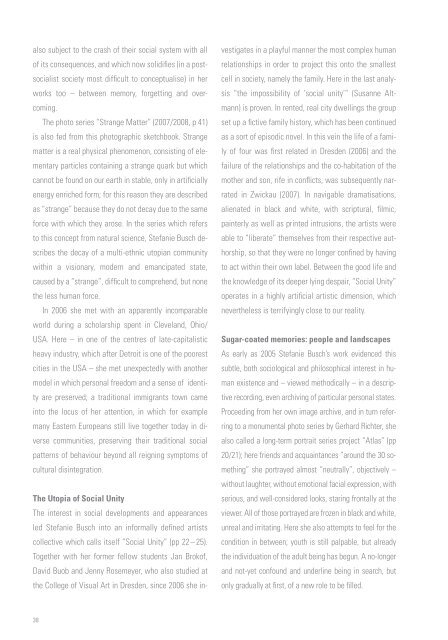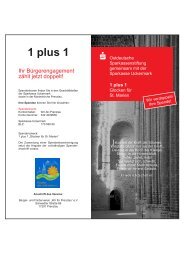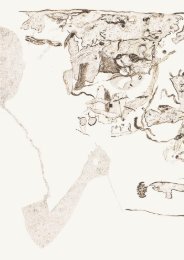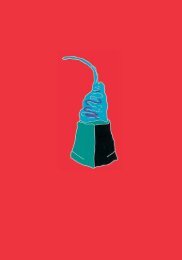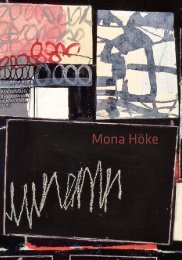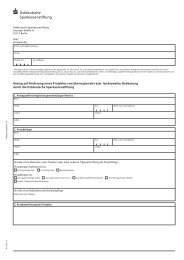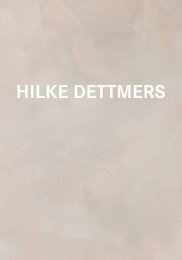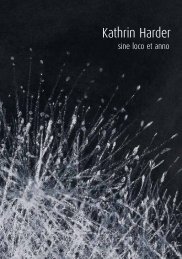Stefanie Busch - Ostdeutsche Sparkassenstiftung
Stefanie Busch - Ostdeutsche Sparkassenstiftung
Stefanie Busch - Ostdeutsche Sparkassenstiftung
Sie wollen auch ein ePaper? Erhöhen Sie die Reichweite Ihrer Titel.
YUMPU macht aus Druck-PDFs automatisch weboptimierte ePaper, die Google liebt.
also subject to the crash of their social system with all<br />
of its consequences, and which now solidifies (in a post-<br />
socialist society most difficult to conceptualise) in her<br />
works too – between memory, forgetting and over-<br />
coming.<br />
3<br />
The photo series “Strange Matter” (2007/2008, p 41)<br />
is also fed from this photographic sketchbook. Strange<br />
matter is a real physical phenomenon, consisting of ele-<br />
mentary particles containing a strange quark but which<br />
cannot be found on our earth in stable, only in artificially<br />
energy enriched form; for this reason they are described<br />
as “strange” because they do not decay due to the same<br />
force with which they arose. In the series which refers<br />
to this concept from natural science, <strong>Stefanie</strong> <strong>Busch</strong> de-<br />
scribes the decay of a multi-ethnic utopian community<br />
within a visionary, modern and emancipated state,<br />
caused by a “strange”, difficult to comprehend, but none<br />
the less human force.<br />
In 2006 she met with an apparently incomparable<br />
world during a scholarship spent in Cleveland, Ohio/<br />
USA. Here – in one of the centres of late-capitalistic<br />
heavy industry, which after Detroit is one of the poorest<br />
cities in the USA – she met unexpectedly with another<br />
model in which personal freedom and a sense of identi-<br />
ty are preserved; a traditional immigrants town came<br />
into the locus of her attention, in which for example<br />
many Eastern Europeans still live together today in di-<br />
verse communities, preserving their traditional social<br />
patterns of behaviour beyond all reigning symptoms of<br />
cultural disintegration.<br />
The Utopia of Social Unity<br />
The interest in social developments and appearances<br />
led <strong>Stefanie</strong> <strong>Busch</strong> into an informally defined artists<br />
collective which calls itself “Social Unity” (pp 22 – 25).<br />
Together with her former fellow students Jan Brokof,<br />
David Buob and Jenny Rosemeyer, who also studied at<br />
the College of Visual Art in Dresden, since 2006 she in-<br />
vestigates in a playful manner the most complex human<br />
relationships in order to project this onto the smallest<br />
cell in society, namely the family. Here in the last analysis<br />
“the impossibility of ‘social unity’” (Susanne Altmann)<br />
is proven. In rented, real city dwellings the group<br />
set up a fictive family history, which has been continued<br />
as a sort of episodic novel. In this vein the life of a family<br />
of four was first related in Dresden (2006) and the<br />
failure of the relationships and the co-habitation of the<br />
mother and son, rife in conflicts, was subsequently narrated<br />
in Zwickau (2007). In navigable dramatisations,<br />
alienated in black and white, with scriptural, filmic,<br />
painterly as well as printed intrusions, the artists were<br />
able to “liberate” themselves from their respective authorship,<br />
so that they were no longer confined by having<br />
to act within their own label. Between the good life and<br />
the knowledge of its deeper lying despair, “Social Unity”<br />
operates in a highly artificial artistic dimension, which<br />
nevertheless is terrifyingly close to our reality.<br />
Sugar-coated memories: people and landscapes<br />
As early as 2005 <strong>Stefanie</strong> <strong>Busch</strong>’s work evidenced this<br />
subtle, both sociological and philosophical interest in human<br />
existence and – viewed methodically – in a descriptive<br />
recording, even archiving of particular personal states.<br />
Proceeding from her own image archive, and in turn referring<br />
to a monumental photo series by Gerhard Richter, she<br />
also called a long-term portrait series project “Atlas” (pp<br />
20/21); here friends and acquaintances “around the 30 something”<br />
she portrayed almost “neutrally”, objectively –<br />
without laughter, without emotional facial expression, with<br />
serious, and well-considered looks, staring frontally at the<br />
viewer. All of those portrayed are frozen in black and white,<br />
unreal and irritating. Here she also attempts to feel for the<br />
condition in between; youth is still palpable, but already<br />
the individuation of the adult being has begun. A no-longer<br />
and not-yet confound and underline being in search, but<br />
only gradually at first, of a new role to be filled.


